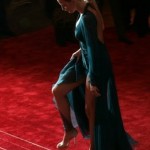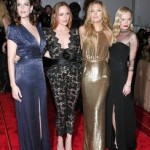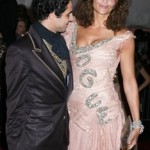16 May Costume Institute Explores Fashion Models as Muses
Wow, here’s a bright idea, actually use a fashion model as a muse, rather than an actress or popstar.
According to the AP:
By Renata Espinosa
New York – While seeing the face of a celebrity on the cover of a fashion magazine or starring in an advertising campaign for Louis Vuitton is the rule, rather than the exception these days, once upon a time it was the professional model who brought the collections of designers like Christian Dior, Cristobal Balenciaga, Yves Saint Laurent, Halston and Calvin Klein to the public, and to life.These women, who functioned as the standards of ideal beauty during any given era and in turn, had a hand in shifting that ideal – from the poise and polish of someone like Dovima in the ’50s, to the waifish Twiggy to the rise of black models like Iman and Beverly Johnson in the ’70s – are the focus of a new exhibit at the Metropolitan Museum of Art’s Costume Institute this spring, “The Model as Muse: Embodying Fashion,” which celebrated its opening at the museum in New York Monday night, May 4, with the annual star-studded gala that is one of fashion’s biggest nights.
Co-chaired by Vogue editor Anna Wintour, Marc Jacobs, Kate Moss and Justin Timberlake, the Costume Institute benefit drew the creme de la creme of past and present models, including Iman, Brooke Shields, Cindy Crawford, Karolina Kurkova and Gisele Bundchen, as well as celebrities who have become some of the new faces of fashion, like Madonna, who has been the face of Louis Vuitton, along with Victoria Beckham and Winona Ryder, both of whom have appeared in Marc Jacobs ad campaigns.
The exhibit traces 50 years of the women who defined their generations, from 1947 to 1997. Starting with the “Golden Age of Haute Couture,” archival issues of Vogue and Harper’s Bazaar with photo spreads of ’50s models such as Carmen Dell’Orefice, Sunny Harnett and Suzy Parker are juxtaposed with tableaux of couture gowns by Balenciaga, Dior and Charles James that reproduce scenes from certain iconic photographs from the time period.
The “youthquake” moment of the 1960’s follows, with a soundtrack of “My Generation” by The Kinks and a projection of “Qui etes-vous Polly Magoo,” the 1960 satire by William Klein against the backdrop of models like Peggy Moffitt wearing the famous topless swimsuit she modeled for Rudi Gernreich and Twiggy’s impossibly tiny silver micromini dress.“Doesn’t it make you want to wear short skirts?” said Harold Koda, curator in charge of the Costume Institute who co-curated the exhibit with Kohle Yohannan.
One of the major themes of the show, as the title suggests, is the way that certain iconic models not only embodied the spirit of a particular moment or season in fashion, but that they also shaped and influenced those fashion.
“To be one of the women that gets pulled out, you not only have to have conformed (to the ideal of beauty), but I think it’s also a happy accident of intersecting with period fashion,” said Koda. “I think in the 1960’s, once you got somebody who was not considered at the beginning a successful model, like Veruschka, who is all legs, it changes the eye and designers want to extend that virtue. So skirts get shorter and shorter, for instance, so I think there’s a subtle, subliminal push forward with the models. But I don’t think there’s a chicken or egg thing. I think it’s simultaneous.”
Yet despite representing an ideal of beauty, Koda pointed out that the most recognizable models – and the ones that designers used time and time again – were the ones who didn’t necessarily have the most perfect faces. Rather, it’s the ones who had the most individualized look.
“There’s this one spread that I remember as a teenager seeing, of Lauren Hutton where she analyzes her face and all of its imperfection,” he said. “But that’s what makes her so beautiful.”
While the ’80s were all about the supermodel, the early ’90s saw a new anti-model trend emerge with people like Kate Moss, who became the poster child for a new grungier mood in fashion. Then, as certain designers began to prize an intellectualized aesthetic of minimalism, the model-as-star fell out of favor – their personalities competed too much with the clothing. This led to the rise of anonymous beauties, a trend that continues into the present.
“In the late ’90s and the early part of the new millennium, all of us have seen shows where there’s one beautiful blonde teenager after another. It used to be, ‘Cindy wore that,’ but you couldn’t do that anymore because it was all about the dress. This is not a bad thing, but it’s a different thing. It’s not using the vivid identity of a woman to carry the dress.”
The exhibit culminates with 1997, a moment that Koda said “was a good tearing off moment because you start to see that fashion goes into this thing where there’s the cult of celebrity, with pop stars and actresses. Rather than have this critical mass of supermodels, you have Gisele.”
“The Model as Muse: Embodying Fashion” will be on view from May 5 through August 9, 2009.


























